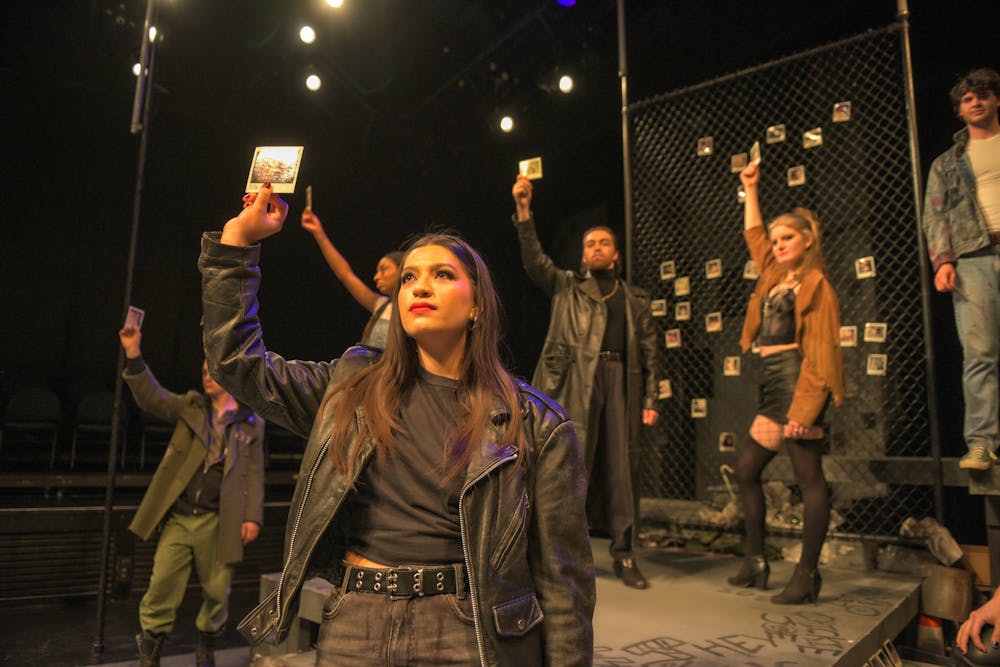“Polaroid Stories,” a play by Naomi Iizuka and directed by Professor of Theatre Alex Draper was performed Nov. 30 through Dec. 2 in the Seeler Studio Theatre in Mahaney Arts Center. The play focuses on at-risk youth coming of age in New York City, filtered through the lens of Greek mythology and Ovid’s “Metamorphoses.” It was inspired by Iizuka’s work with at-risk teenagers who have fallen through the cracks of society and Jim Goldberg’s photo book “Raised by Wolves.”
“I have always wanted to do the play because of the poetic, almost percussive beauty of its language, its focus on stories of those often overlooked or ignored, and the amazing challenges and opportunities for growth the roles offer an ensemble of actors,” Draper wrote in an email to The Campus.
The show opens as Philomel (Elsa Marrian ’25) descends down a dark staircase, singing “Hestia” by Katell Keineg. Then, the scene pans to the ten youths milling around an urban sprawl set filled with fences, garbage and graffiti. Through a series of darkly visceral vignettes, the show chronicles four main relationships in parallel: Orpheus and Eurydice; D, Skinhead Boy and Skinhead Girl; Echo and Narcissus; and Persephone and G.
Iizuka challenges the audience’s traditional notions about Greek heroes and channels Ovid to bring the forgotten youth on the fringes of society to center stage. In contrast to the musical retelling “Hadestown,” Ovid’s Orpheus (Jonathan Mount ’25.5) is an abusive, selfish man whose desires cannot be satisfied as he pursues Eurydice (Jordan Henry ’26), a fearless girl searching for a place to call home. What started as fresh love gets twisted into fear and obsession, culminating in Orpheus's death at the hands of Eurydice towards the final moments of the play.
In one scene, D (movement director Miguel Alejandro Castillo ’19), an arrogant, entrepreneurial man who runs a club and grounds the show with a mature lens, flirts with Skinhead Boy (Jack Barnhart ’25.5), an insecure energetic youth who goads him about his masculinity. The scene explores tensions surrounding societal expectations for men and their sexuality. Later, Skinhead Boy robs D’s stash of drugs with his girlfriend, Skinhead Girl (Patrice Cahill ’25), and D finds out. Skinhead Boy tries to live above the law and escape society’s expectations of him, but after his girlfriend overdoses, Skinhead returns to work for D, who strangles a confession out of him. The acute scenes of violence and drugs force the audience to bear witness to the gruesome realities of society.
Throughout the play, various characters smoke joints, pop pills and inject heroin. During the rehearsal process, each actor researched the drugs that their character uses and spoke with local emergency room doctor Mike Kiernan about each drug’s effects. By spotlighting the impacts of drugs and alcohol, Iizuka forces the audience to grapple with the crisis of addiction. Audience members reflected their appreciation for the show touching on intense topics.
“I thought the show was very good,” said Cole Newman ’26, who watched the play last weekend. “It was very hard in some places, but also felt like it touched on some very important topics that are not often talked about and it was very great to see.”
Throughout the show, contrasting light and dark lighting called chiaroscuro along with audiovisual effects sculpted the stage into a 1990s urban landscape. In one mesmerizing scene, Skinhead Girl dashes through the slivers of light crisscrossing the dark stage. In another scene, the characters attend a rave with ’90s music carefully chosen by Castillo and Professor Amit Prakash, including Sandstorm by Darude.
“I went to a rave and that song came on, and I watched how people acted,” said Castillo.
The vivid audiovisual effects also enhanced the visceral emotional experience of the audience.
“I think it really challenges the audience to experience the show as it happens without reading into it, or trying to craft some overarching narrative,” said Grayson Wade ’26.
The show culminates in a powerful final scene in which each actor held up a Polaroid photo and shared the names of individuals from “Raised by the Wolves” and imaginary characters crafted by Iizuki, which was repeated from the opening scene. The names and photos created a shrine to those left behind and represented how lives may splinter apart, but humans still uphold the people they love in their own ways.
“Each one tiny and shimmering, each one a perfect living thing,” D said.
Through its dark vignettes, “Polaroid Stories,” chronicles addiction, rape, theft and love in relationships amongst at-risk youth, calling into question the virtues of our society, which casts out so many.
“I thought that this show has been the best show I have seen at Middlebury ever and I have been to a lot of them,” said Makeda Hevrin ’24.5. “Beautifully done, beautifully acted and beautifully set, and I thought the subject matter was really pertinent.”




